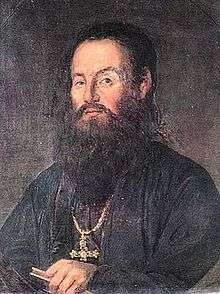Anthimos Gazis

Anthimos Gazis (or Gazes; Ἄνθιμος Γαζῆς; 1758 in Milies – 1828 in Ermoupoli, Syros) was a Greek scholar, philosopher during the Greek Enlightenment, cartographer and one of the heroes of the Greek War of Independence against the Ottoman Empire. He was born in Milies (Thessalia) in Ottoman Greece in 1758 and died in 1828. His real name was Anastasios Gazalis (Ἀναστάσιος Γκάζαλης).
Biography
Gazis studied in Greece and then he went to Constantinople where he was ordained a priest. He became rector of the Greek Church of Vienna in 1797. In 1811 he received his Diploma from the “Philological Institute of Bucharest”. In 1813 Gazis was elected a Member of the Bavarian Academy of Sciences. His efforts were concentrated to the development of a higher education system in Greece.
He was the editor of the very first periodical in Greek, Hermes o Logios, published in Vienna. In 1799, he translated and published Benjamin Martin’s “Philosophical Grammar”.
Gazis published in 1800 Vienna a map of Greece and the Balkans called Pinax Geographikos tes Hellados (Πίναξ Γεωγραφικὸς τῆς Ἑλλάδος). It is a reduced edition of the famous map of Rigas Feraios (the Charta of Greece). He edited also a worldmap called Atlas e Chartes [...] hydrogeiou...,[1][2] owned today by the National Library of Australia.
In 1821, he was the main figure of the Insurrection of Thessalia against the Ottomans; after the rapid defeat of the insurgents in Thessalia and the invasion of the Pelion by Mahmud Dramali Pasha in the summer, he had to flee to the Sporades islands. He was a member of the Areopagus of Eastern Continental Greece from November 1821.
Notes
- ↑ Transliterated as Atlas e charte geographikes ton dyo Hemisphairion mela diaphoron Thesontes sphairos... in the article Gazes, Santini and the Sydney 2000 Paralympics
- ↑ Ατλας ή χάρτης περιέχων καθολικούς γεωγραφικούς πίνακες της υδρογείου σφαίρας κατά τε την ορθήν παράλληλον και πλαγίαν αυτής θέσιν την τε παραλληλόγραμμον και αλλοιότροπον γενικήν καταγραφήν της υδρογείου σφαίρας και ημικύκλιον περιέχον παλαιών τόπων ονομασίας κατά Διονύσιον τον Περιηγητήν, και μερικόν πίνακα της Βλαχίας, προς δε τα τε συστήματα και τας σφαίρας και τους πλανήτας και σχήματα τα τας σφαίρας θέσεις δεικνύοντα και τους ανέμους και άλλα πολλά προς γενικήν είδησιν γεωγραφίας και αστρονομίας συντείνοντα. Πονηθείς χάριν των φιλομαθών υπό Γεωργίου y ατού [sic] ενδοξοτάτου Άρχοντος μεγάλου Βογνίκου Ραδουκάνου Γολέσκου και Αναλώμασι τύποις εξεδόθη. αω’ 1800. (See article Η παλιά κορνίζα της Βιβλιοθήκης έκρυβε θησαυρό by Yiota Myrtsioti.)
